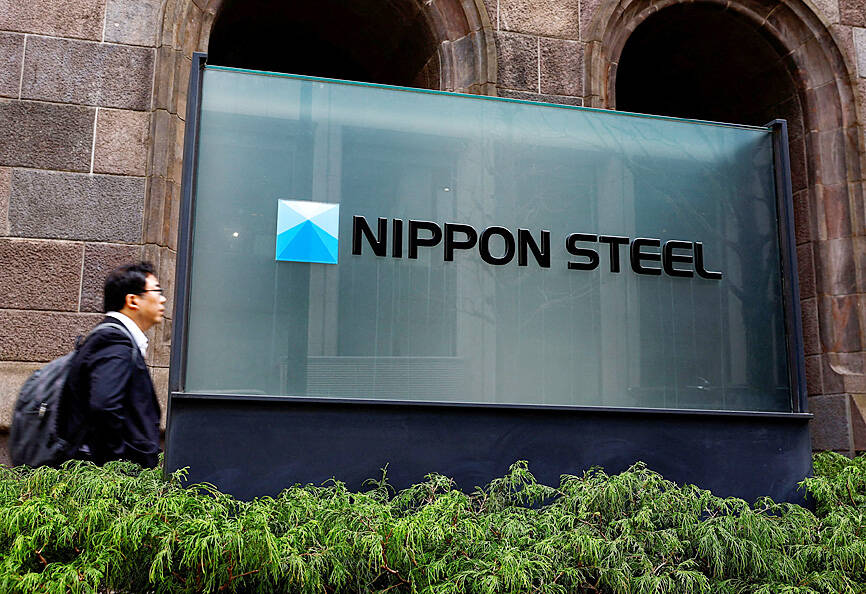Japan’s Nippon Steel Corp is seeing support for its proposal to acquire US Steel Corp in the regions of the US where steel mills are located, Nippon Steel president Tadashi Imai told reporters yesterday.
On Monday, a US inter-agency foreign investment committee referred the decision of whether to approve or block the US$15 billion deal to US President Joe Biden, who has 15 days to decide.
Biden and US president-elect Donald Trump have expressed opposition to the purchase.

Photo: Reuters
Nippon Steel has made a number of commitments to address the national security concerns of the Committee on Foreign Investment in the United States, Imai said, adding that he believed there was “progress in understanding.”
“In the communities of the various regions where the steel mills are located, there is a considerable amount of support for this acquisition,” Imai said. “I hope that President Biden will understand ... the value of this acquisition to the US economy.”
Both companies have previously said they planned to close the deal, which has also faced opposition from the powerful United Steelworkers (USW) labor union, before the end of this year.
Nippon Steel yesterday shared a letter with Biden dated on Monday and signed by two dozen US municipality officials in areas where US Steel mills are located, asking the US president to approve the takeover deal.
“We respectfully urge you to listen to the voices of the steelworkers and everyone else whose economic security is tied to US Steel — they are speaking loudly in unison that this deal must be approved,” the letter said.
USW met Nippon Steel officials twice last week, the union said in a separate statement.
USW repeated its view that the Japanese steelmaker had no interest in the long-term security of US Steel plants or blast furnace operations, and urged Biden to keep the company domestically owned and operated, it said.
To win support for the acquisition, Nippon Steel has previously said it would not use the deal as cover to import steel and has made a series of pledges to protect jobs and invest in US facilities it sees as key to its future growth.

Taiwan Semiconductor Manufacturing Co (TSMC, 台積電) last week recorded an increase in the number of shareholders to the highest in almost eight months, despite its share price falling 3.38 percent from the previous week, Taiwan Stock Exchange data released on Saturday showed. As of Friday, TSMC had 1.88 million shareholders, the most since the week of April 25 and an increase of 31,870 from the previous week, the data showed. The number of shareholders jumped despite a drop of NT$50 (US$1.59), or 3.38 percent, in TSMC’s share price from a week earlier to NT$1,430, as investors took profits from their earlier gains

In a high-security Shenzhen laboratory, Chinese scientists have built what Washington has spent years trying to prevent: a prototype of a machine capable of producing the cutting-edge semiconductor chips that power artificial intelligence (AI), smartphones and weapons central to Western military dominance, Reuters has learned. Completed early this year and undergoing testing, the prototype fills nearly an entire factory floor. It was built by a team of former engineers from Dutch semiconductor giant ASML who reverse-engineered the company’s extreme ultraviolet lithography (EUV) machines, according to two people with knowledge of the project. EUV machines sit at the heart of a technological Cold

Taiwan’s long-term economic competitiveness will hinge not only on national champions like Taiwan Semiconductor Manufacturing Co. (TSMC, 台積電) but also on the widespread adoption of artificial intelligence (AI) and other emerging technologies, a US-based scholar has said. At a lecture in Taipei on Tuesday, Jeffrey Ding, assistant professor of political science at the George Washington University and author of "Technology and the Rise of Great Powers," argued that historical experience shows that general-purpose technologies (GPTs) — such as electricity, computers and now AI — shape long-term economic advantages through their diffusion across the broader economy. "What really matters is not who pioneers

TAIWAN VALUE CHAIN: Foxtron is to fully own Luxgen following the transaction and it plans to launch a new electric model, the Foxtron Bria, in Taiwan next year Yulon Motor Co (裕隆汽車) yesterday said that its board of directors approved the disposal of its electric vehicle (EV) unit, Luxgen Motor Co (納智捷汽車), to Foxtron Vehicle Technologies Co (鴻華先進) for NT$787.6 million (US$24.98 million). Foxtron, a half-half joint venture between Yulon affiliate Hua-Chuang Automobile Information Technical Center Co (華創車電) and Hon Hai Precision Industry Co (鴻海精密), expects to wrap up the deal in the first quarter of next year. Foxtron would fully own Luxgen following the transaction, including five car distributing companies, outlets and all employees. The deal is subject to the approval of the Fair Trade Commission, Foxtron said. “Foxtron will be